|
ENG 305U-001/41119 Native American Cinema
Dr. Grace L. Dillon. 725-8144/dillong@pdx.edu CH 117Q.
Office Hours: Wednesday, 12:30-1:30 p.m., Thursday 2:30-3:30 p.m. and
by appointment.
Class meets MW 4:40-6:30 p.m./Location: NASCC 170
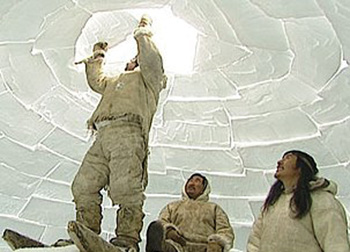 Requirements:
Dialogue journal responses (30 %) and a final exam (40 %) are part
of the course load but, in addition, you will have the opportunity in
your panel presentations (30 %) to contemplate creating your own cinematography
as an engaged interactive postmodern “trickster” responding to the “self-representations”
within Native American cinema. Requirements:
Dialogue journal responses (30 %) and a final exam (40 %) are part
of the course load but, in addition, you will have the opportunity in
your panel presentations (30 %) to contemplate creating your own cinematography
as an engaged interactive postmodern “trickster” responding to the “self-representations”
within Native American cinema.
Dialogue
Journal Responses: You will hand in one journal a week which can
be written for either your Monday or Wednesday session selections. In
these two-three page typewritten journals, you will respond to assigned
writing prompts relating to the readings and generally the topics noted
in class: Specific (and possible) directions will be provided for you
from time to time. These responses will aid you in reflecting on the partnered discussions
or quick workshops at the beginning of sessions and in synthesizing
the material. In sorting out
the meaning of each article or assigned reading provide your own concrete
film and/or cultural examples that are relevant to the areas noted for
that particular session. Using the Internet Movie Data Base at http://www.imdb.com is a handy tool to recall or check out the names
of characters in your films selected.
Panel
Presentations: You will join a generally three-four member group
and collaborate on a 25-30 minute presentation applying film theory,
postcolonial theory, or any other pertinent theory to samples of films
you have in mind. Of course,
here, you may also choose to join in the activism of creating your own
video. I would recommend here
a very short-short cinema piece of three to four minutes or so for the
actual video with ample time to discuss your project experience. You
will start forming your group and choosing your topic by the end of
the second week. Be sure to use mainly library-documented sources
or scholarly venues online for these presentations.
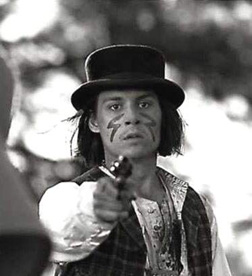 Final
Exam: Your final exam will consist of three parts:
a section requiring you to define key terms with stipulative
examples provided for each and two sections requiring you to write two
well-documented essays. Final
Exam: Your final exam will consist of three parts:
a section requiring you to define key terms with stipulative
examples provided for each and two sections requiring you to write two
well-documented essays.
Attendance:
Because this class emphasizes group workshops
and interactive discussions, absences are discouraged. Each absence after the first three lowers your
grade one level. If you miss
more than two weeks’ worth of classes, you should consider dropping
this course and retaking it when your schedule permits.
Required Texts:
1) Singer, Beverly R. Wiping the War Paint Off the Lens: Native American Film and Video.
Minneapolis: University
of Minnesota Press, 2001.
[Wiping the War Paint]
2)
Reading Packet : Available at Clean
Copy. (Broadway ) [Pck.]
Course Schedule: The day-to-day schedule follows. Note that you should complete the reading assignments
by the day on which they are listed.
WEEK ONE:
M 1/9 Introduction.
Sherman Alexie’s Business
of Fancy Dancing (2002) clip.
W 1/11 Chris Eyre’s Smoke
Signals(1998)
and Michael J. F. Scott’s Spirit
Rider(1993). Reading:
Wiping the War Paint
1-13
and chapter 5, “On the way to smoke Signals.” Transrealism/slipstream and Indigenous
aesthetics.
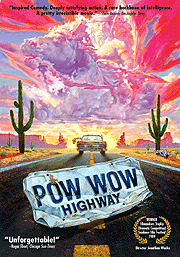 WEEK
TWO: WEEK
TWO:
M 1/16 Martin
Luther King Holiday. Campus closed.
W 1/18 Jonathan Wacks’s Powwow Highway (1989)
and Michael Apted’s Incident at Oglala: The Leonard Peltier Story(1992) and Rage Against the Machine: Live in Concert documentary (1997). Reading: Ward Churchill’s “Fantasies of the
Master Race: Categories of Stereotyping of American Indians in Film.”
(Pck.) Rest of
Wiping the War Paint. Buddy movies, sleep
B-films, and cult films.
WEEK THREE:
M 1/23 Jim
Jarmusch’s Dead Man (1995). Reading:
Jacquelyn Kilpatrick’s “The Sympathetic
1980s and 1990s.” Celluloid
Indians. (Pck.) cf. Johnny Depp’s The Brave (1997) and Jim Jarmusch’s Ghost Dog:
The Way of the Samurai(1999) American Indian ethnic renewal.
W 1/25 John Ford’s The
Searchers (1956), Kevin Costner’s Dances
with Wolves(1990),
Michael Mann’s The Last of the
Mohicans and Ron Howard’s The
Missing (2004). Reading: JoEllen
Shively’s “Cowboys and Indians: Perceptions of Western Films Among
American Indians and Anglos.” (Pck.)
Retrospectives on revisionism,
captivity narratives, “going Indian.” and western traditions.
WEEK
FOUR:
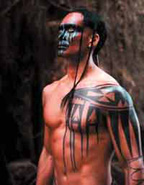 M
1/30 Antonia
Bird’s Ravenous (2000), Christopher
Gans’ Brotherhood of the Wolf (2002), Grant Harvey’s Ginger Snaps Back: The Beginning(2004),Andrew Raj
Berzins and Norma Bailey’s Cowboys and Indians: The J. J. Harper Story (2003). Reading:
Robert Stam’s “The Poetics and Politics of
the Postmodern.” (Pck.)
Postmodernism, anti-western traditions, and the windigo
spirit. Intimate intersections and forbidden frontiers. M
1/30 Antonia
Bird’s Ravenous (2000), Christopher
Gans’ Brotherhood of the Wolf (2002), Grant Harvey’s Ginger Snaps Back: The Beginning(2004),Andrew Raj
Berzins and Norma Bailey’s Cowboys and Indians: The J. J. Harper Story (2003). Reading:
Robert Stam’s “The Poetics and Politics of
the Postmodern.” (Pck.)
Postmodernism, anti-western traditions, and the windigo
spirit. Intimate intersections and forbidden frontiers.
W 2/1
Bruce Bereford’s Black Robe ( 1991), Xavier
Kaller’s Squanto: A Warrior’s Tale (1994) and John Fusco and Steven Barron’s Dreamkeeper (2004).
cf. Wisdom of the Mohawk Keepers
(1999). Readings:
Jace Weaver’s “From I-Hermeneutics to We-Hermeneutics:
Native Americans and the Post-Colonial” and Robert Stam’s “Film and the Postcolonial.” (both
Pck.) Modern re-shapings
of early encounters
between Americans and English missionaries. Postcolonial
theory.
 WEEK
FIVE: WEEK
FIVE:
M 2/6 Chris Eyre’s Skins
(2002), Randy Redwood’s Doeboy
(2001). Faye Ginsburg’s
“Shooting Back: From Ethnographic Film to Indigenous production/ Ethnography
of Media.” (Pck.) The native
indie production chain of sharing and collaboration.
W 2/8
Chris Eyre’s Skinwalkers Cf. Coyote
Waits. Readings:
Vivian Sobchak’s ‘The Scene of the Screen:
Envisioning Cinematic and Electronic Presence” and Robert Eberwein’s
“The IFC and Sundance: Channeling
Independence.” (Pck.) Cinematic techniques and production
methods.
WEEK
SIX:
M 2/13 Sherman Alexie’s
Business of Fancy Dancing revisited along with Bruce McDonald’s Dance Me Outside(1994). cf. Stephan Elliott’s
Adventures of Priscilla: Queen
of the Desert (1994) and Shelley Niro’s
Honey Moccasin (1998). Two-Spirit nature,
images of masculinity, and the contemporary urban American Indian. Indigenous queer theory and masculinity studies
including Terry Tafoya’s “M. Dragonfly: Two-Spirit
and the Tafoya Principle of Uncertainty” and Peter van Lent’s
“Her Beautiful Savage: The Current Sexual Image of the Native
American Male” referenced in class.
 W
2/15 Valerie
Red Horse’s Naturally Native
(1998), Shelley Niro’s Honey Moccasin
(1998), and Chris Eyre’s Edge of America(2005). Reading:
Leonie Pihama’s “Mana
Wahine Theory: Creating Space for Maori Women’s Theories.”
(Pck.) Devon Abbott Mihesuah’s Indigenous
American Women: Decolonization, Empowerment, and Activism referenced
in class. Female friendship. W
2/15 Valerie
Red Horse’s Naturally Native
(1998), Shelley Niro’s Honey Moccasin
(1998), and Chris Eyre’s Edge of America(2005). Reading:
Leonie Pihama’s “Mana
Wahine Theory: Creating Space for Maori Women’s Theories.”
(Pck.) Devon Abbott Mihesuah’s Indigenous
American Women: Decolonization, Empowerment, and Activism referenced
in class. Female friendship.
FILM FESTIVAL
on Saturday, February 18, NASCC co-sponsored by AISES focusing on native
and indigenous cinema. Come join
this community and bring friends.
WEEK
SEVEN:
M 2/20 Joe Johnston’s Hildago(2004), Spike Jonze’s Adaptation(2003), Lasse
Hallstrom’s Chocolat(2000), and Edward Zwick’s
The Last Samurai
Reading:
James Clifford’s “Diasporas.” (Pck.)
Mixed bloods,cross-bloods,
the debate of diasporic communities in tension/conflict
with indigenous locals, and the exchanges, negotiations of minor to
minor transnational imaginaries
W 2/22 Zacharias Kunuk’s Fast Runner
(Atanarjuat)(2002) Reading:
Faye Ginsburg’s “Embedded Aesthetics.” (Pck.)
Northern exposure. Narratives
of revenge, self-reliant hero as anti-social response, and re-connecting
communities.
WEEK
EIGHT:
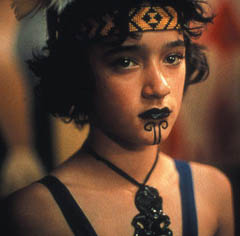 M
2/27 Panel presentations. M
2/27 Panel presentations.
W 3/1 Niki Caro’s Whale Rider(2002), Lee
Tamahori’s Once Were
Warriors (1995), and Phillip Noyce’s Rabbit Proof Fence (2002). cf. Stephen Lawrence, Nick Torrens, and Phil
Lucas’s Vis-à-vis Native Tongues(2003) and
Simon Wincer’s Quigley Down Under (1990). Southern exposure. Female
warriors, boarding school education, overgoing
internal colonization, and aboriginal counter-resistances.
WEEK
NINE:
M 3/6 Panel
presentations.
W 3/8
Gerald Vizenor’s Harold and Orange(1984), Stuart Margolin’s
Medicine River (1993) and Charlie Hill’s On and Off the Rez
(2000). Reading:
Jacquelyn Kilpatrick’s “The American Indian Aesthetic.” (Pck.) The art
of miindiwag,
Gerald Vizenor’s double-coded humour,
the postindian, and survivance
meets Mikhail Bakhtin’s dialogical intertextuality
and the carnivalesque.
AISES Conference
on March 10 and 11, NASCC.
WEEK TEN:
M 3/13 Panel
presentations.
W 3/15
TBA
Final Exam Schedule: Take-home final
exam due by 5:20 p.m. on Monday, March 20.
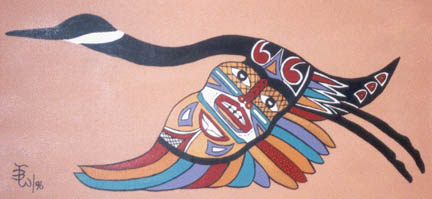
|


![]()